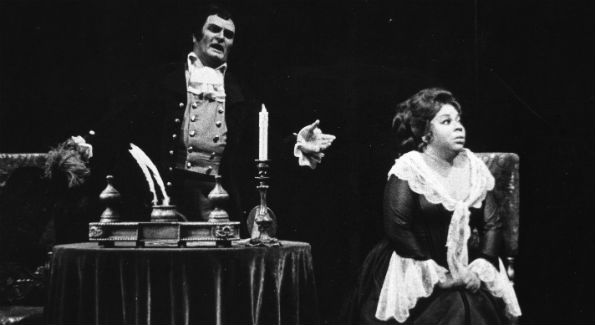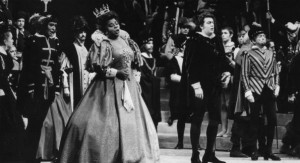Legendary opera soprano Martina Arroyo opens up on the defining moments of her career.
By Patrick D. McCoy

Martina Arroyo performs in Verdi’s La Forza del Destino Act I with Jon Vickers.
(Photo Credit: The Metropolitan Opera Courtesy of The Martina Arroyo Foundation)
The iconic career of opera soprano Martina Arroyo was recently highlighted at the 36th annual Kennedy Center Honors. As Kennedy Center Chairman David Rubenstein said, “Martina Arroyo has dazzled the world with her glorious soprano voice and continues to share her artistry with a new generation of opera singers.” Washington Life sat down with her to chat about her love of mentoring young singers, her many operatic roles and the joy she found in working while supporting her passion of singing.
Washington Life: When you were a student at Hunter College, we understand that you studied voice more as a hobby. What was the turning point that fueled this hobby into a serious musical interest?
Martina Arroyo: I can’t say that there was an exact turning point. I certainly know that being in the workshop and taking lessons little by little began to take over my life because I found myself wanting to do that more than many of the other things that a teenager would want to do; more than go out and dance or be with my pals. Then, I found myself going into the crowd with the people who did sing opera. It was not until after going into the Met auditions, beginning to audition for different parts, that it meant a lot to me. I did not like losing competitions and things like that. I learned that there were other wonderful singers out there who were wonderfully prepared, not necessarily better and that I had to keep working. It was a healthy experience. I had my share of wins and that helped too.
WL: What do you recall most about your Metropolitan Opera debut in 1958 as the Celestial Voice in Verdi’s Don Carlo? That marked a long association with that prestigious house.
MA: I recall being very, very excited about it. I had to stand on a ladder. I was elated. First of all, your colleagues come around and say nice things. You realize that you are standing on this stage with singers like Leonie Rysnik and Nel Rankin. You’re taken into a very warm atmosphere and they were very warm to me. My mother missed it because she went to the bathroom. It was the last thing in that act. She came to the second performance and came to every performance of my life as long as she lived. All of a sudden, you are in a profession that other people think you are worthy to be there.
WL: Your first starring role at The Met was as Aida in a last-minute replacement for Birgit Nilsson. What was that pivotal moment like and how did it influence your career?
MA: Yes, but I didn’t think so. I thought I was not starring, but a major part of any of the Wagner Rhinemaidens (the three water-nymphs in Richard Wagner’s opera cycle Der Ring des Nibelungen). You have to feel like you are a part of a very big thing that is important … You begin to know the importance of everyone in that cast.
WL: You were the first black singer to portray the role of Elsa in Wagner’s Lohengrin. Share with us how you have personally experienced the “face” of opera change to include a myriad of artists from all walks of life and nationalities.
MA: I did not go at [it] as “the first black singer to sing Elsa,” I wanted to sing a beautiful Elsa. There were people who thought Rudolph Bing (General Manager of The Metropolitan Opera, 1950-1972) had lost his mind. But, they did everything to help make it just right for me. I did not dress in all silver. I had more gold in my hair so that it helped my complexion look like everyone else on stage. I don’t think he was trying to make us look white, but rather a more unified feeling on stage. Mr. Bing thought that an Italian voice could sing and should sing German opera, and I think he was right. If anybody had their doubts, maybe they changed over and maybe they didn’t. That was not my problem. I did the best Elsa that I could do and if it was not right for me, it did not have anything to do with me being black. But as it turned out, my voice was good in the Wagnerian repertoire, particularly the lyric roles.
WL: What was your approach to learning the many signature roles you have performed on stage?
MA: I did not sing a character unless I loved her. I did not want to put her skin on unless I wanted to live in her skin. Of course I love Turandot, Tosca and Amelia in ‘Un Ballo in Maschera.’ I don’t remember singing a part that I didn’t like and if I did, I only sang it once. There are roles that I wanted to sing, like ‘Norma,’ and was supposed to have sung, but there is no role that I actually performed on stage that I did not feel a lot for the character. For me, ‘Lady Macbeth’ was a big study because she had vocal colors that I had not used in other characters. That was fun!

Don Carlo opening night with Martina Arroyo and Placido Domingo (center).
(Photo Credit: The Metropolitan Opera Courtesy of The Martina Arroyo Foundation)
WL: You have demonstrated such a rich commitment to new generations of opera singers through your mentorship program Prelude to Performance. How did this evolve into an internationally heralded training program?
MA: Prelude to Performance is our summer program in which participants perform complete operas with orchestra. We choose from nearly 500 people to cast those two performances and they work thoroughly for six weeks. They have the opportunity to work with 20 of the best coaches in languages, movement and acting. The development of this program has been well-received by the young people and has made its name in the U.S. as well as Europe.
WL: During the Kennedy Center Honors tribute presentation, singers from The Martina Arroyo Foundation sang in your honor. What was it like to see your influence in these young artists?
MA: When those kids walked out there, I nearly fell off that balcony. We hugged and it was so special. It made everything right. I was so glad that it was not about 40 years ago. Forty years ago I can’t even remember. When they came out, it was about today and what is happening now. If you have any value at all, it is because of what you are doing today.
WL: You share the same initials of 1978 Kennedy Center honoree Marian Anderson, an important artist in American history.
MA: Marian Anderson influenced music for all people, all over the world. Not only was she a great representative of the arts in the best way, she pursued her career and encouraged others. No matter how you looked at her, it was always up. I went to her home a couple of times and she was a source of love and encouragement.
WL: What was it like as a young artist yourself to balance work while trying to study singing? What kind of advice do you have for the emerging artists that you work with in your foundation who may be experiencing the same thing?
MA: First of all, you work because you need to support what you want to do most. So what you want to do most is not work. That is what it’s about and that makes you happy. That makes you feel fulfilled. I hope young people enjoy their work because I enjoyed my work very much. I didn’t go to work with a long face. I went to work, very involved with the older people that I met with while working as a case worker at the welfare department and finally with the young students when I was student teaching. You don’t have to have one or the other as opposites. You can have joy in both places, always knowing where you hope to end up. One of the things that make you happy in the profession is knowing that you can feed yourself and not worry about your rent. If something should happen and you can’t have a singing career, you can still have a joyful and meaningful life.
WL: What do you think is the future of opera as it relates to younger audiences?
MA: You can talk about that as much as you want to. Are you talking about the future of opera being produced with modern staging, getting into the schools teaching opera and classical music to young people sooner so that it is not such a big shock when they get older? There are so many things to be discussed here. I don’t think that we are ever going to let opera die. I hear beautiful voices all the time. Yes, there will be another Marian Anderson. I think there is a future for opera.
Martina Arroyo accepted the 2013 Kennedy Center Honor along with fellow honorees Herbie Hancock, Billy Joel, Shirley MacLaine and Carlos Santana.
Recently named among the Forty Under 40 for his contributions to arts and humanities, Patrick D. McCoy received a B.M. in vocal performance from Virginia State University and a M.M. in church music from the Shenandoah Conservatory in Winchester, Va. , where he serves on the alumni board of directors. He has contributed arts and culture pieces to CBS Washington, The Afro-American Newspaper and the newly published book, “In Spite of the Drawbacks” (Association of Black Women Historians), which includes his chapter on legendary soprano Leontyne Price. McCoy has interviewed some of the most acclaimed artists of our time, including Renée Fleming, Joshua Bell, Martina Arroyo, Denyce Graves, Eric Owens, Norman Scribner, Julian Wachner, Christine Brewer and Lawrence Brownlee. He is music director at Trinity Episcopal Church, DC. Listen to these interviews and others at Blog Talk Radio. McCoy may be reached via email at wlperformingarts@aol.com and on Twitter @PatrickDMcCoy.




